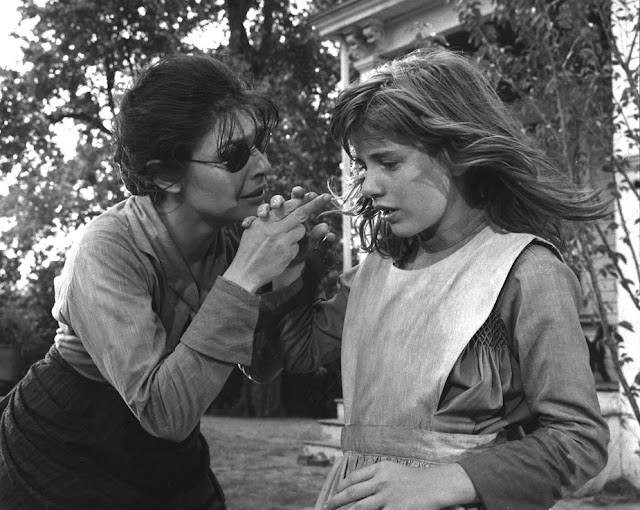 |
| Anne Bancroft and Patty Duke in The Miracle Worker (1962) |
It seemed like an impossible task. How does one teach a young girl who is blind, deaf, and mute how to communicate with the world? It would take a teacher of great strength who would persist against all odds. It would take a miracle worker.
As a toddler, Helen Keller (Patty Duke) contracts a serious illness which leaves her blind then deaf. There are few resources for the Keller family and they raise her as best as they know how. Mother Kate Keller (Inga Swenson) dotes on her child, Captain Arthur Keller (Victor Jory) fusses over the situation and their oldest son James (Andrew Prine) thinks it's all a hopeless cause. Years pass and Helen has gotten worse. Spoiled by parents and servants who want nothing but to calm her down, Helen is in a chaotic state. Unkempt, erratic and with little understanding of the world around her, the Kellers are at their wits end. They take a chance on a teacher who offers to work with Helen. As soon as Annie Sullivan (Anne Bancroft) arrives she gets to work on Helen. Trying to teach her words through sign language, decorum through example, and everything through repetition. It's an exhausting task as Helen fights her tooth and nail and the Kellers, including Aunt Ev (Kathleen Comegys), get in the way more than they help. It seems like Annie has the most difficult job in the world: to teach Helen how to communicate and to be a part of the world around her.
 |
| Inga Swenson, Victor Jory, Andrew Prine, Patty Duke and Anne Bancroft in a scene from The Miracle Worker (1962) |
The Miracle Worker (1962) is based on William Gibson's play about Helen Keller and her teacher Anne Sullivan. Much of the inspiration comes from Keller's own autobiography. Gibson's play debuted on live television on Playhouse 90 and went on to become a popular Broadway production starring both Anne Bancroft and Patty Duke. Bancroft won a Tony Award for her performance. It was inevitable that The Miracle Worker would be adapted to film. According to Anne Bancroft biographer Douglass K. Daniel, William Gibson was dismayed by the play-to-film failure of his work Two for the Seesaw and wanted to make sure that didn't happen again. He collaborated with producer Fred Coe and director Arthur Penn. The three started a production company called Playfilm Productions and United Artists financed and distributed the film.
Bancroft and Duke almost didn't get their parts. United Artists wanted Audrey Hepburn or Elizabeth Taylor to ensure a financial return on their investment. Duke was almost not considered because it was thought she was getting too old for the part. Thank goodness Gibson stood his ground because Bancroft and Duke deliver masterful performances and I can't imagine the film without either of them.
 |
| Patty Duke and Helen Keller |
The film was nominated for 5 Academy Awards including Best Director (Arthur Penn), Best Writing (William Gibson) and Best Costume Design (Ruth Morley). It's no surprise that Anne Bancroft won for Best Actress in a Leading Role and Patty Duke won Best Actress in a Supporting Role. Bancroft was not at the ceremony to accept her award and actress Joan Crawford accepted it on her behalf. Duke was the youngest actor to win a non-honorary Oscar until Tatum O'Neal broke the record in 1974.
The Miracle Worker (1962) is a film that grabs hold of you and won't let you go. It requires all of your concentration which you will so willingly give because the subject matter is fascinating. The film itself is not a miracle rather a result of hard work and a lot of talent. When I watched it I felt equal parts exhausted and enlightened. It's a complicated and brilliant film that breaks you down and builds you back up.
The Miracle Worker (1962) is available on DVD and Blu-Ray from Olive Films.
Thank you to Olive Films for sending me a copy of this film to review!


















